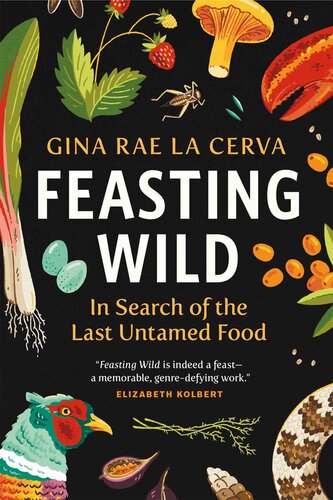
Feasting Wild
In Search of the Last Untamed Food
کتاب های مرتبط
- اطلاعات
- نقد و بررسی
- دیدگاه کاربران
نقد و بررسی

March 15, 2020
A geographer and environmental anthropologist travels the globe in search of those who hunt and gather in the midst of civilization. Although La Cerva pays some attention to those who pick mushrooms and weeds for food and medicine, she focuses mostly on those who kill animals--often illegally, though in line with historical and cultural traditions--chronicling her time in Maine, Scandinavia, Poland, Borneo, and, particularly, the Democratic Republic of Congo. Eating at the world-famous Copenhagen restaurant Noma, the author ruminates on how the act of serving tiny portions of wild foods--including "caramel made from sourdough bread yeast served with Icelandic yogurt and sea buckthorn flower marmalade"--is in some ways a "fetishization of need." La Cerva prefers the fried grasshoppers she and her friends ate as children in New Mexico, which "tasted like some kind of discordant freedom." In chapters that bounce precipitously from topic to topic, the author manages to keep a steady eye on her central concern: the contradictions inherent in eating "wild" meat at this point in human history. She shows sympathy for those who hunt and sell "bushmeat," including monkeys and elephants, but not for the rich at home and abroad who use this meat as a sign of status. A narrative strand about her romantic entanglement with a Swedish conservationist--who coordinates anti-poaching efforts at a rainforest reserve and whose "narrow lips arch into two perfect mountains at the center, surrounded by deep smile lines, like the walls of a canyon valley"--follows a fairly predictable path and contributes little to the story. Throughout, La Cerva demonstrates her ability for diligent observation, and if her prose is sometimes overwrought, it also offers glimpses of human activities that have grown increasingly rare--e.g., butchering a moose or gathering birds' nests for soup. For armchair adventurers, a competent examination of the pros and cons of living off the land.
COPYRIGHT(2020) Kirkus Reviews, ALL RIGHTS RESERVED.

Starred review from March 23, 2020
La Cerva, a geographer and environmental anthropologist, explores in her impressive debut humans’ relationship to wild food and the disappearing places and animals that provide it. Starting at Noma, the Michelin-starred Danish restaurant that relies exclusively on local and wild ingredients, La Cerva explores how “the seemingly archaic practice of gathering wild plants is having a resurgence.” She travels to several continents to explore the landscapes that once provided a natural abundance of food but have been dramatically impacted by development, climate change, and shifting values. She recalls her “feral” upbringing in New Mexico (where she picked “the fuzzy hairs of prickly pears out of my fingers, the tips stained red from the peeling of the fleshy fruit”); travels to Poland to explore her ancestral roots (“I withdrew toward the wilderness to strip away the superficialities—to regain contact with the essential”) as she wanders through “grasslands filled with rare birds”; and meets folks living off the land, such as “The Hunter,” a Swede living in the Congo who also heads an anti-poaching patrol in local national parks. La Cerva’s beautifully written narrative is as tantalizing as it is edifying.

April 15, 2020
Have we come full circle in our eating habits? Our distant ancestors had to rely on nature's basic nutrients scavenged from plants and animals that inhabited the planet alongside them. These prototypical locavores had to search the ground for sustenance, and use their primitive tools to down any game that might crawl, slither, or bound within range. After millennia of eating plants grown in tilled fields and then generations eating meats transported by sophisticated machines, adventurous eaters are rediscovering wild plants and animals with unique flavors. Meeting up with a decidedly contrarian chef, environmental anthropologist La Cerva explores the maps of taste, observing cultural aversions to eating insects and the shortcomings of today's reliance on industrial animal husbandry. Her search for wild edibles takes her to Poland and one of the last forests that shelter wild boar, and to Asia for birds' nests to be turned into soup. This is a good introduction for anyone interested in novel, nonstandard sources of food for present and future and includes a bibliography.(Reprinted with permission of Booklist, copyright 2020, American Library Association.)

























دیدگاه کاربران